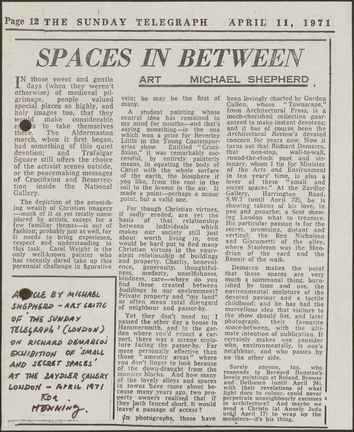Henning Christiansen
1971-04-00
Afsender
Richard Demarco
Modtager
Henning Christiansen
Dokumentindhold
Anmeldelse af Richard Demacros udstilling "Small and Secret Places", Zaydler Gallery, London, april 1971.
Transskription
ARTICLE BY MICHAEL SHEPHERD – ART CRITIC OF THE ‘SUNDAY TELEGRAPH’ (LONDON) ON RICHARD DEMARCOS EXHIBITION OF ‘SMALL AND SECRET PLACES’ AT THE ZAYDLER GALLERY LONDON – APRIL 1971
FOR
HENNING
Page 12 THE SUNDAY TELEGRAPH APRIL 11, 1971
SPACES IN ETWEEN
ART MICHAEL SHEPHERD
In those sweet and gentle days (when they weren’t otherwise) of medieval pilgrimage, people valued special places so highly, and holy images too, that they would make considerable efforts to take themselves there. The Aldermaston march, when it first began, had something of this quiet devotion; and Trafalgar Square still offers the choice of the activist scenes outside, or the peacemaking messages of Crucifixion and Resurrection inside the National Gallery.
The depiction of the astonishing wealth of Christian imagery – much of it as yet totally unexplored by artists, except for a few familiar themes – is out of fashion; probably just as well, for it needs to bring experience, respect and understanding to this task. Carel Weight is the only well-known painter who has recently dared take up this perennial challenge in figurative vein; he may be the first of many.
A student painting whose central idea has remained in my mind for months – and that’s saying something – is the one which won a prize for Beverley Little in the Young Contemporaries show. Entitled “Crucifixion”, it was remarkably successful, by entirely painterly means, in equating the body of Christ with the whole surface of the earth, the biosphere if you like, from the root in the soil to the breeze in the air. It made a point – perhaps a minor point, but a valid one.
For though Christian virtues, if sadly eroded, are yet the basis of that relationship between individuals which makes our society still just about worth living in, one would be hard put to find many Christian virtues in the equivalent relationship of buildings and property. Charity, benevolence, generosity, thoughtfulness, modesty, unselfishness, kindness, care – where do you find these created between buildings in our environment? Private property and “my land” so often mean total disregard of neighbor and passer-by.
Yet they don’t need to: I passed the other day a house in Hammersmith, and in the garden where you’d expect a carport, there was a serene sculpture facing the passer-by. Far more personally effective than those “amenity areas” where you don’t linger to look because of the down-draught form the monster blocks. And how many of the lovely alleys and spaces in towns have come about because many years ago, two property owners realized that if they both fenced short, it would leave a passage of access?
In photographs, these have been lovingly charted by Gordon Cullen, whose “Townscape” from Architectural Press, is a much-cherished collection guaranteed to make instant devotees; and it has of course been the Architectural Review’s devoted concern for years now. Now it turns out that Richard Demarco, that non-stop, wall-to-wall, round-the clock poet and visionary, whom I tip for Minister of the Arts and Environment in ten years’ time, is also a lover of these “small and secret spaces". At the Zaydler Gallery, Harrington Road, S.W.7 (until April 22), he is showing tokens of his love, in pen and gouache; a Scot showing London what to treasure. His particular passion is for the secret, promising, distant and vertical; the Ben Nicholson and Giacometti of the alley, where Stapleton was the Mondrian of the yard and the Renoir of the walk.
Demarco makes the point that these spaces are very much a communal thing, burnished by time and use, the environmental sculpture of the devoted paviour and a tactile childhood; and he has had the marvelous idea that visitors to the show should list, and later photograph, their favourite space-between with the ultimate intention of publication. It certainly makes one consider who, environmentally, is one’s neighbor, and who passes by on the other side.
Surely anyone, too, who responds to Bernard Dunstan’s lovely paintings at Roland, Browse and Delbanco (until April 24), with their revelationsof what light does to colour, could never perpetrate unneighbourly excesses in architecture? And maybe we need a Christo (at Annely Juda until April 17) to wrap up the monsters – it’s his thing.
